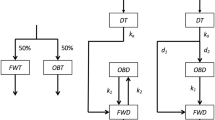Abstract
THE turnover of stable strontium, a minor mineral constituent of the diet, chemically similar to calcium, has been studied in man in order to compare the metabolic behaviour of strontium and calcium and to estimate the accumulation of fall-out strontium-90 in the body, ingested at a constant rate over a long period. So far, little information has been obtained from studies of children because the experiments have involved giving doses of the radioactive isotope. Measurements of the residence time of strontium in children aged less than one year have been obtained, however, by comparing the amounts of natural strontium ingested and excreted1,2, but for the study of older children this method is unreliable because the accumulated strontium approaches a state of equilibrium attained in adult life. In previous work in this laboratory, the accumulation of strontium and calcium in four children aged 4–14 yr was studied by giving doses of 100 mg of natural strontium3, but because the normal dietary intake at these ages is only 1 mg a day, these large doses may have disturbed the balance of strontium in the body and invalidated the conclusions of the experiments. In the work reported here, we have overcome this problem—and at the same time avoided giving doses of radioactive isotopes to children—by using stable strontium enriched in 84Sr (Oak Ridge Laboratories). The information on strontium turnover could thus be obtained whilst the subjects consumed a normal diet with a normal content of natural strontium.
This is a preview of subscription content, access via your institution
Access options
Subscribe to this journal
Receive 51 print issues and online access
$199.00 per year
only $3.90 per issue
Buy this article
- Purchase on Springer Link
- Instant access to full article PDF
Prices may be subject to local taxes which are calculated during checkout
Similar content being viewed by others
References
Harrison, G. E., Sutton, A., Shepherd, H., and Widdowson, E. M., Brit. J. Nutrit., 19, 111 (1965).
Kahn, B., Straub, C. P., Robbins, P. J., Wellman, H. N., Seltzer, R. A., and Telles, N. C., Pediatrics, 43, 651 (1969).
Bedford, J., Harrison, G. E., Raymond, W. H. A., and Sutton, A., Brit. Med. J., 1, 589 (1960).
Sutton, A., Harrison, G. E., Carr, T. E. F., and Barltrop, D., Intern. J. Radiat. Biol., 19, 79 (1971).
Harrison, G. E., Raymond, W. H. A., and Tretheway, H. C., Clin. Sci., 14, 681 (1955).
Barnes, D. W. H., Bishop, M., Harrison, G. E., and Sutton, A., Intern. J. Radiat. Biol., 3, 637 (1961).
Author information
Authors and Affiliations
Rights and permissions
About this article
Cite this article
SUTTON, A., SHEPHERD, H., HARRISON, G. et al. Excretion and Retention of Stable Strontium in Children. Nature 230, 396–397 (1971). https://doi.org/10.1038/230396a0
Received:
Issue Date:
DOI: https://doi.org/10.1038/230396a0
Comments
By submitting a comment you agree to abide by our Terms and Community Guidelines. If you find something abusive or that does not comply with our terms or guidelines please flag it as inappropriate.



